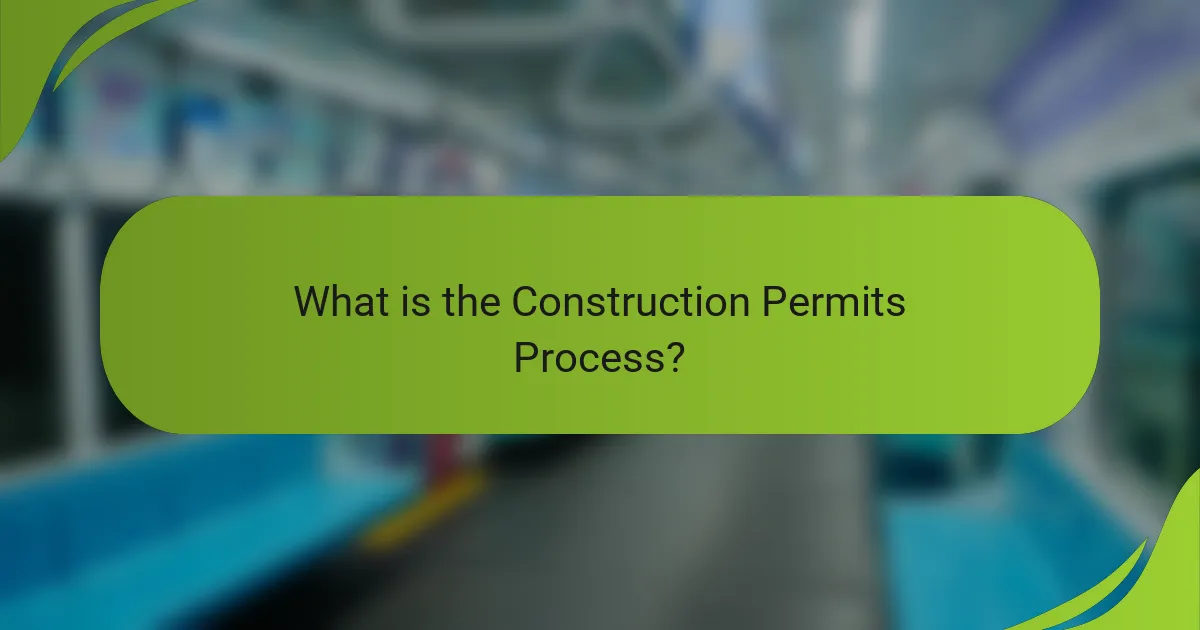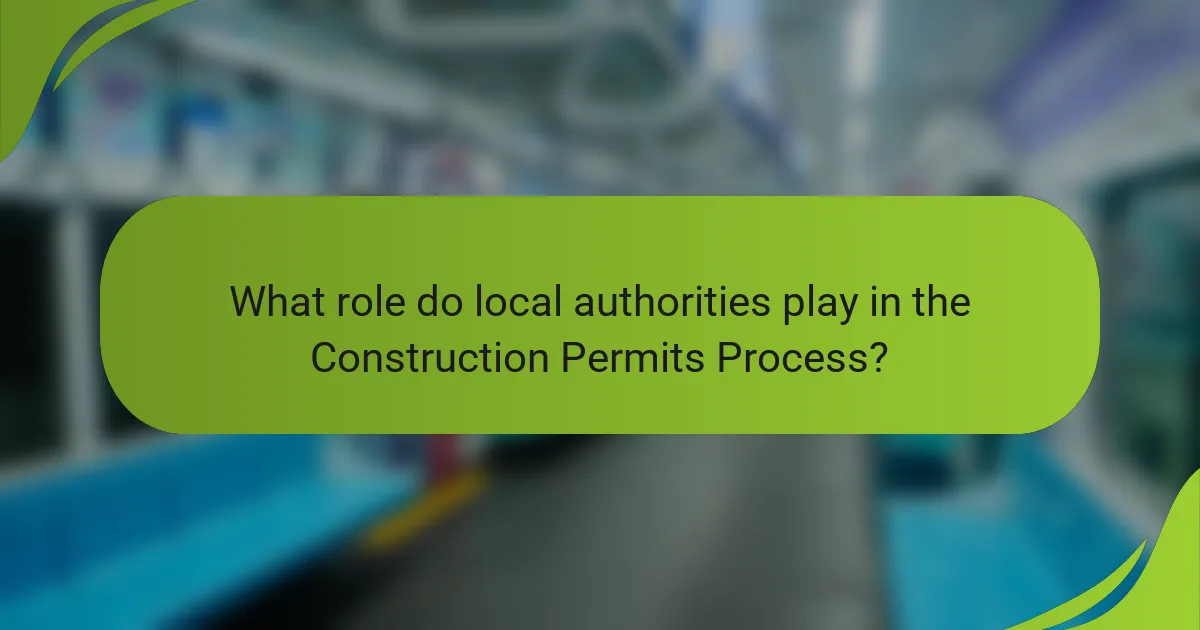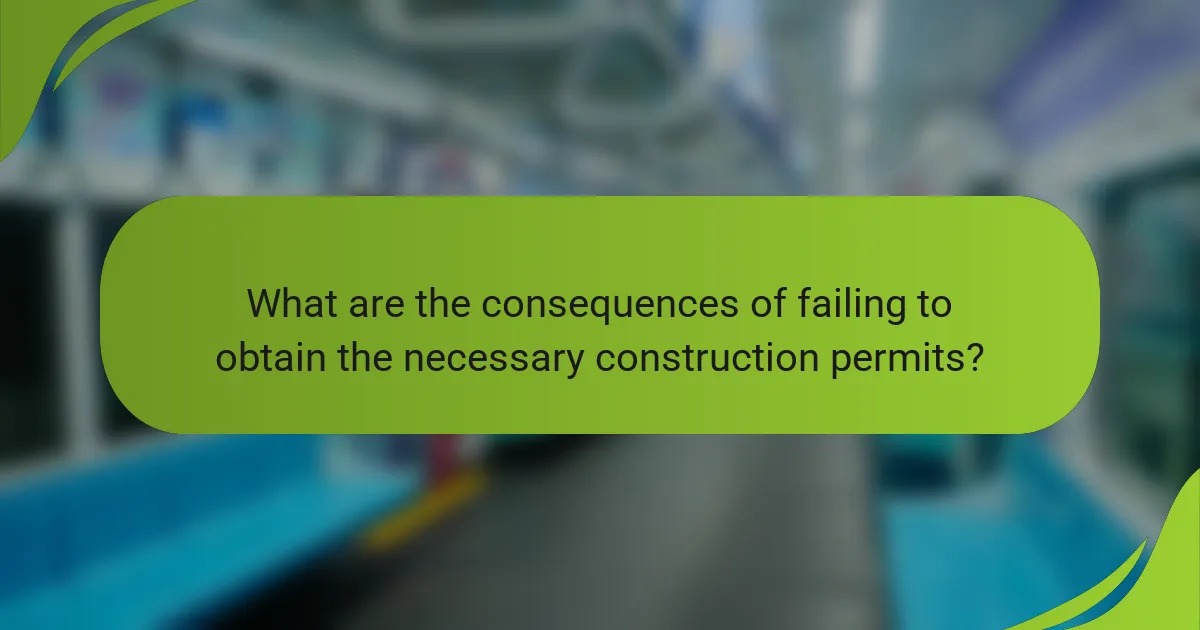The construction permits process is essential for obtaining official permission to initiate building projects. This process involves submitting applications, paying fees, and providing detailed plans for local building departments to review for compliance with zoning laws and safety codes. Local authorities play a critical role in evaluating applications, conducting inspections, and issuing final approvals to ensure adherence to regulations. Failure to secure necessary permits can lead to significant legal and financial repercussions, including fines, project delays, and potential legal action from local governments. Understanding the steps and requirements of the construction permits process is crucial for maintaining regulatory compliance and avoiding costly consequences in building projects.

What is the Construction Permits Process?
The construction permits process is a series of steps required to obtain official permission to begin construction. This process typically includes submitting an application, paying fees, and providing detailed plans. Local building departments review the plans for compliance with zoning laws and safety codes. After review, the department may issue a permit, allowing construction to proceed. Inspections are often required at various stages to ensure adherence to regulations. Failure to obtain the necessary permits can result in fines and project delays. Each jurisdiction may have specific requirements and timelines for the process.
How does the Construction Permits Process impact building projects?
The Construction Permits Process significantly impacts building projects by ensuring compliance with local regulations. This process establishes safety standards, zoning laws, and environmental guidelines. Delays in obtaining permits can extend project timelines and increase costs. For example, a study by the National Association of Home Builders found that permitting delays can add up to 20% to project costs. Additionally, proper permits help prevent legal issues and fines. They also facilitate inspections, ensuring that construction meets safety and quality standards. Overall, the Construction Permits Process is crucial for the successful completion of building projects.
What are the key stages in the Construction Permits Process?
The key stages in the Construction Permits Process include application submission, review, approval, and issuance of permits. Initially, applicants submit required documents and plans to the relevant authority. This is followed by a review phase where officials assess compliance with zoning laws and building codes. After a thorough evaluation, the authority either approves or denies the application. If approved, the final stage involves the issuance of the construction permit, allowing the project to commence. Each stage is crucial for ensuring regulatory compliance in building projects.
Why is understanding the Construction Permits Process essential for builders?
Understanding the Construction Permits Process is essential for builders to ensure compliance with local regulations. This process outlines the necessary approvals required before construction begins. It helps builders avoid legal issues and potential fines. Additionally, understanding permits can streamline project timelines. Builders who grasp the process can better manage costs associated with delays. Accurate knowledge of permits also enhances communication with regulatory authorities. Furthermore, it fosters safer building practices by ensuring adherence to safety standards. Ultimately, this understanding contributes to successful project completion and client satisfaction.
What are the primary types of construction permits?
The primary types of construction permits include building permits, electrical permits, plumbing permits, mechanical permits, and occupancy permits. Building permits are required for new construction or significant renovations. Electrical permits are necessary for any electrical work being performed. Plumbing permits are needed for new plumbing installations or modifications. Mechanical permits cover HVAC installations and alterations. Occupancy permits are issued once construction is complete, ensuring the building meets safety codes. Each permit type ensures compliance with local regulations and safety standards.
How do different types of permits vary based on project scope?
Different types of permits vary based on project scope by addressing specific regulatory needs for distinct construction activities. For example, a building permit is required for new structures or significant renovations, while a demolition permit is necessary for tearing down existing buildings. A zoning permit ensures compliance with land use regulations, which is crucial for projects affecting land development. Environmental permits may be needed for projects impacting natural resources, reflecting the project’s ecological footprint. Each permit type corresponds to the complexity and impact of the project, ensuring that relevant safety, environmental, and community standards are met. This differentiation helps streamline the regulatory process, aligning permits with the specific requirements of varying project scopes.
What specific requirements are associated with each type of construction permit?
Specific requirements vary by construction permit type. Building permits generally require detailed plans, site inspections, and compliance with local codes. Electrical permits necessitate electrical plans and inspections by licensed electricians. Plumbing permits demand plumbing diagrams and inspections to ensure safety and compliance. Mechanical permits require plans for HVAC systems and inspections for efficiency and safety. Demolition permits often need environmental assessments and safety plans. Each permit type has unique documentation and compliance standards based on local regulations. This ensures safety and adherence to building codes.
What are the common challenges faced during the Construction Permits Process?
The common challenges faced during the Construction Permits Process include lengthy approval times. Delays often arise from incomplete applications or missing documentation. Regulatory compliance can be complex, leading to confusion among applicants. Variations in local codes may result in additional requirements. Communication issues with regulatory agencies can further complicate the process. Stakeholder disagreements may also cause delays in obtaining necessary permits. Additionally, unexpected changes in project scope can necessitate new permits, prolonging the timeline. These challenges can significantly impact project schedules and budgets.
How can delays in the Construction Permits Process affect project timelines?
Delays in the Construction Permits Process can significantly extend project timelines. These delays often result from lengthy review periods, missing documentation, or compliance issues. Each delay pushes back the start date of construction activities. According to a study by the National Association of Home Builders, delays in permitting can add 6 to 12 months to project timelines. This extended timeline can increase overall project costs due to prolonged financing and labor expenses. Furthermore, delays can disrupt project schedules, affecting subcontractors and suppliers. The cumulative effect can lead to missed deadlines and potential penalties. Thus, timely processing of construction permits is crucial for maintaining project efficiency.
What strategies can be employed to overcome these challenges?
To overcome challenges in the construction permits process, stakeholders should employ several strategies. First, they can establish clear communication with regulatory agencies. This ensures all requirements are understood from the outset. Second, they should conduct thorough research on local regulations. Understanding specific zoning laws and building codes is crucial for compliance. Third, utilizing technology can streamline the application process. Software solutions can help manage documentation and track submissions efficiently. Fourth, engaging experienced consultants can provide valuable insights. Professionals familiar with the local landscape can navigate complexities effectively. Fifth, organizing pre-application meetings with authorities can clarify expectations. These meetings allow for early identification of potential issues. Lastly, maintaining flexibility in project timelines can accommodate unforeseen delays. This approach helps manage stakeholder expectations and project costs.
How can one effectively navigate the Construction Permits Process?
To effectively navigate the construction permits process, start by researching local regulations. Understanding specific requirements is crucial for compliance. Next, prepare all necessary documentation. This often includes site plans, project descriptions, and contractor information. Submit the application to the appropriate local authority. Each jurisdiction has different submission procedures and fees. Monitor the application status regularly. Follow up with officials to address any questions or additional requirements. Attend public hearings if required, as this may influence approval. Lastly, be prepared for inspections during and after construction. These steps ensure adherence to regulations and facilitate a smoother process.
What best practices should be followed when applying for construction permits?
Start the construction permit application process early. This allows ample time for revisions and approvals. Ensure all required documents are complete and accurate. Missing or incorrect information can delay the process. Familiarize yourself with local zoning regulations and building codes. Compliance with these regulations is essential for approval. Engage with local authorities early in the process. This helps clarify requirements and expectations. Consider hiring a professional, such as an architect or permit expeditor. Their expertise can streamline the application process. Keep records of all communications and submissions. Documentation can aid in resolving any issues that arise. Finally, be prepared for inspections and follow-up requests. Addressing these promptly can facilitate a smoother approval process.
How can builders ensure compliance with local regulations during the process?
Builders can ensure compliance with local regulations by thoroughly researching and understanding all applicable codes. This includes zoning laws, safety standards, and environmental regulations. Builders should consult local building departments for specific requirements. Engaging with architects and engineers can also provide insights into regulatory compliance. Regularly reviewing project plans against local regulations helps maintain adherence. Documenting all communications and approvals is essential for accountability. Additionally, obtaining necessary permits before construction begins is crucial. Builders should stay updated on any changes in local regulations throughout the project.

What role do local authorities play in the Construction Permits Process?
Local authorities are responsible for overseeing the construction permits process. They evaluate applications to ensure compliance with local building codes. Local authorities also conduct inspections during the construction phase. These inspections confirm that the work adheres to approved plans and regulations. Additionally, they issue final approvals once all requirements are met. This role helps maintain safety and quality standards in building projects. Local authorities also provide guidance on zoning laws and land use. Their involvement is crucial for regulatory compliance in construction.
How do local regulations influence the Construction Permits Process?
Local regulations significantly influence the Construction Permits Process. They establish the legal framework that governs construction activities. These regulations dictate the types of permits required for various projects. They also outline the necessary documentation and compliance standards. Local zoning laws determine land use and building specifications. Building codes set safety and structural requirements for construction. Environmental regulations may impose additional assessments or permits. Failure to comply with these regulations can result in fines or project delays.
What are the responsibilities of local authorities in issuing permits?
Local authorities are responsible for assessing and approving permit applications. They ensure compliance with local zoning laws and building codes. Authorities evaluate the safety and environmental impact of proposed projects. They also conduct inspections during construction to verify adherence to approved plans. Additionally, local authorities may issue permits for various activities, including construction and renovation. They are tasked with maintaining public records of all issued permits. Authorities also provide guidance to applicants throughout the permitting process. These responsibilities ensure that construction projects meet community standards and regulations.
How can builders communicate effectively with local authorities?
Builders can communicate effectively with local authorities by establishing clear channels of communication. Regular meetings can help build rapport and ensure mutual understanding. Utilizing formal communication methods, such as emails and official letters, maintains professionalism. Providing detailed project documentation aids in transparency and clarity. Listening to feedback from authorities demonstrates respect for their expertise and regulations. Engaging in community outreach fosters goodwill and cooperation. Being proactive in addressing concerns can prevent misunderstandings and delays. Following these practices leads to smoother interactions and compliance with regulations.
What resources are available for understanding the Construction Permits Process?
Resources available for understanding the Construction Permits Process include government websites, local building departments, and industry associations. Government websites often provide detailed guidelines and requirements for obtaining permits. Local building departments can offer specific information tailored to regional regulations. Industry associations may offer resources such as guides, webinars, and workshops on the permitting process. Additionally, online platforms and forums can facilitate discussions with experienced professionals. These resources collectively help stakeholders navigate the complexities of construction permits effectively.
How can online platforms assist in navigating the permits process?
Online platforms streamline the permits process by providing centralized access to necessary information. They offer digital applications that reduce paperwork and speed up submission. Users can track application status in real-time, enhancing transparency. Online platforms also provide guidance on requirements and deadlines, minimizing confusion. Many platforms include resources like FAQs and chat support for immediate assistance. They often integrate with local government databases for up-to-date regulations. This integration ensures compliance with current laws and reduces the risk of delays. Overall, online platforms simplify and expedite the permits process for users.
What role do professional consultants play in the Construction Permits Process?
Professional consultants play a critical role in the Construction Permits Process. They assist clients in navigating complex regulatory requirements. Consultants provide expertise in local building codes and zoning laws. They help prepare necessary documentation for permit applications. This includes site plans, engineering reports, and environmental assessments. Their knowledge reduces the likelihood of application errors. They also facilitate communication with regulatory agencies. This streamlines the approval process and minimizes delays. Ultimately, their involvement ensures compliance and enhances project success.

What are the consequences of failing to obtain the necessary construction permits?
Failing to obtain the necessary construction permits can lead to significant legal and financial consequences. Authorities may impose fines for non-compliance, which can vary by jurisdiction. Additionally, construction may be halted until permits are secured, causing project delays. This can result in increased labor and material costs. Property owners may also face legal action from local governments. In some cases, unauthorized construction may lead to the requirement to demolish existing structures. Insurance claims may be denied if permits are not obtained, leaving property owners financially vulnerable. Overall, the lack of permits can severely impact project timelines and budgets.
What legal implications can arise from non-compliance?
Non-compliance with construction permit regulations can lead to significant legal implications. These may include fines imposed by regulatory authorities. In some cases, project delays can occur due to stop-work orders. Legal action may be initiated by affected parties, including neighbors or local governments. Non-compliance can also result in the revocation of permits, halting project progress. Furthermore, liability for damages may arise if non-compliance leads to safety hazards. Courts may enforce compliance through injunctions or other legal remedies. Each of these implications underscores the importance of adhering to construction regulations.
How can builders mitigate risks associated with permit violations?
Builders can mitigate risks associated with permit violations by ensuring comprehensive compliance with local regulations. They should conduct thorough research on zoning laws and building codes before starting any project. Engaging with local authorities early in the planning process can clarify requirements. Builders should also maintain accurate documentation of all permits and approvals obtained. Regular training for staff on compliance issues can further reduce risks. Utilizing technology, such as permit management software, can streamline tracking and updates. Additionally, hiring a compliance officer can help oversee adherence to regulations. These strategies collectively minimize the likelihood of violations and associated penalties.
What practical tips can help streamline the Construction Permits Process?
To streamline the construction permits process, ensure all documentation is complete and accurate. This includes site plans, architectural drawings, and environmental assessments. Familiarize yourself with local regulations and requirements. Each municipality may have different rules that can affect processing times. Engage with local officials early in the process. This can clarify expectations and expedite approvals. Use online submission systems when available. Many jurisdictions offer digital platforms that speed up the review process. Additionally, consider hiring a professional permit expeditor. They can navigate the complexities of the system efficiently. Finally, maintain open communication with all stakeholders involved. This helps address issues promptly and keeps the project on track.
How can thorough documentation benefit the permit application process?
Thorough documentation can streamline the permit application process by providing clear evidence of compliance. This clarity helps regulatory bodies assess applications more efficiently. Accurate and complete documentation reduces the chances of delays caused by missing information. It also minimizes the need for additional requests for clarification from authorities. Furthermore, organized documentation can enhance transparency and accountability in the application process. A study by the National Association of Home Builders found that complete applications are processed 30% faster than incomplete ones. Thus, thorough documentation significantly contributes to a smoother and quicker permit approval process.
What timelines should builders anticipate when applying for permits?
Builders should anticipate varying timelines when applying for permits. Typically, the process can take anywhere from a few weeks to several months. The exact duration depends on the complexity of the project and local regulations. Simple permits may be approved in as little as 2 to 4 weeks. More complex projects often require 3 to 6 months for approval. Some jurisdictions may have expedited processes, reducing wait times. Delays can occur due to incomplete applications or public hearings. Builders should consult local authorities for specific timelines relevant to their projects.
The main entity of the article is the Construction Permits Process, which encompasses the necessary steps for obtaining official permission to initiate building projects. The article details the stages involved in this process, including application submission, review, and permit issuance, while emphasizing the importance of compliance with local regulations and building codes. It highlights the impact of delays on project timelines and costs, outlines various types of construction permits, and discusses common challenges faced during the permitting process. Additionally, it provides practical strategies for builders to navigate the process effectively, ensuring adherence to safety and regulatory standards.